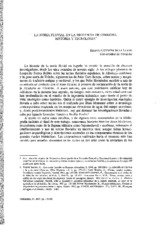La noria fluvial en la provincia de Córdoba. Historia y tecnología
Autor
Córdoba de la Llave, Ricardo
Editor
Facultad de Filosofía y Letras. Departamento de Ciencias de la Antigüedad y Edad MediaFecha
1997Materia
Norias fluvialesMolinos de agua
Ingeniería hidráulica
Córdoba (Provincia, España)
METS:
Mostrar el registro METSPREMIS:
Mostrar el registro PREMISMetadatos
Mostrar el registro completo del ítemResumen
La noria fluvial ha sido utilizada desde hace siglos en la provincia de Córdoba para elevar agua de los ríos y regar las huertas establecidas en sus inmediaciones. La mayoría de ellas estaba situada en los ríos Genil, Guadajoz y Guadalquivir, y muchas de esas norias se han mantenido en uso hasta el siglo XX. La primera parte del trabajo se dedica a reunir los diversos testimonios históricos que nos informan sobre el uso de las norias fluviales en Córdoba: lugares de emplazamiento, períodos de actividad, finalidad de uso. La segunda parte analiza los rasgos técnicos de las norias a través del estudio de dos modelos diferentes: la noria de piezas de madera, de tradición medieval, algunos de cuyos ejemplares se han conservado en lugares como Palma del Río y Castro del Río hasta los años setenta del presente siglo; y la noria con elementos de hierro fundido, de diseño más moderno, muy utilizada desde mediados del siglo XIX y de la que todavía se conserva algún ejemplar, como la situada en el curso del río Genil cerca de la aldea de Jauja (Lucena). The fluvial waterwheel has been used for centuries in the province of Córdoba in order to rise water from the rivers and to irrigate the vegetable gardens located along the rivers. Most of them were placed along the Genil, Guadajoz, and Guadalquivir rivers and they have been in use until the 20th century. The first part of the work is dedicated to join the historical references about the waterwheels: location, periods of activity and the purpose of their use. The second part analyzes the technical charasteristics of the waterwheels through a study of two different models: from the medieval tradition, the wooden waterwheel (sorne examples of which have been preserved in places like Palma del Río and Castro del Río up until the 1970's) and, second, the waterwheel with steel-casted elements. This one, with a more modern design, was the most used since the middle of the 19th century. Preserved examples, like the waterwheel near Jauja (Lucena) village, can still be found along the Genil river.

